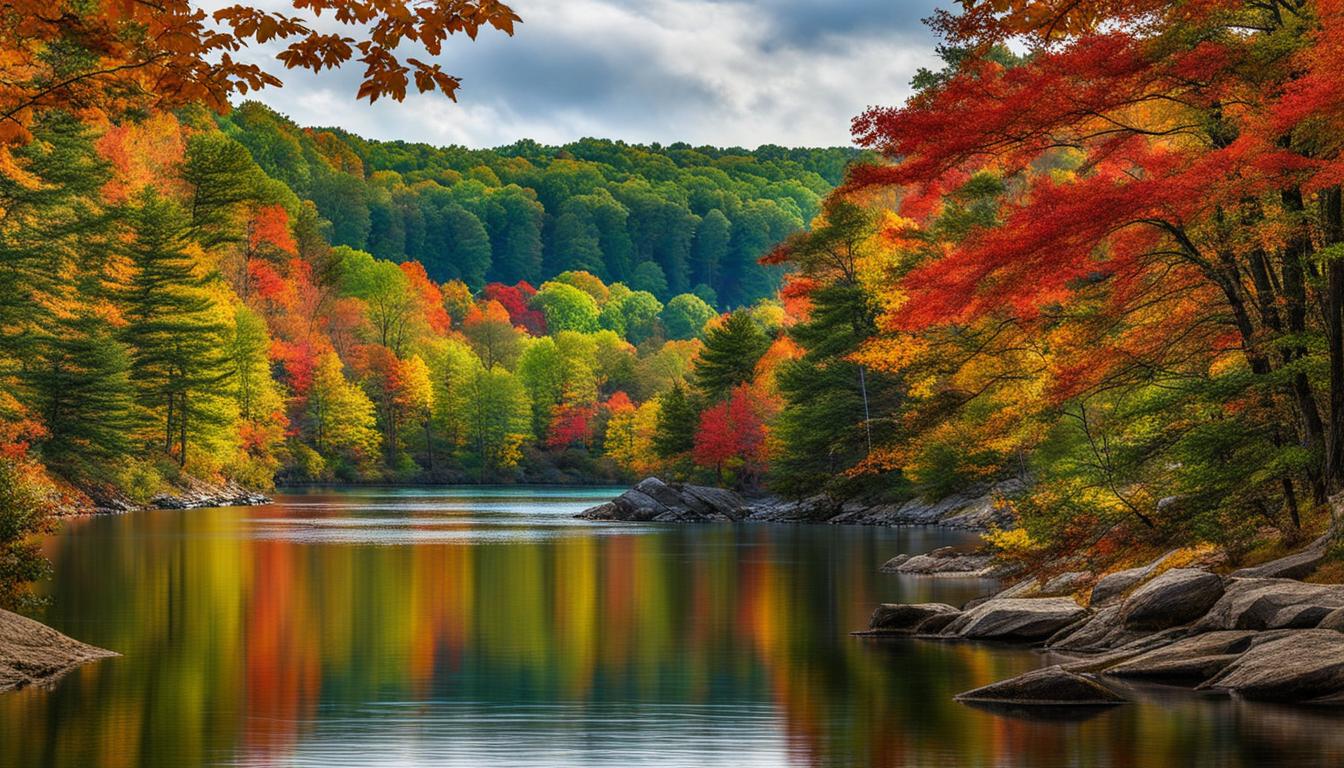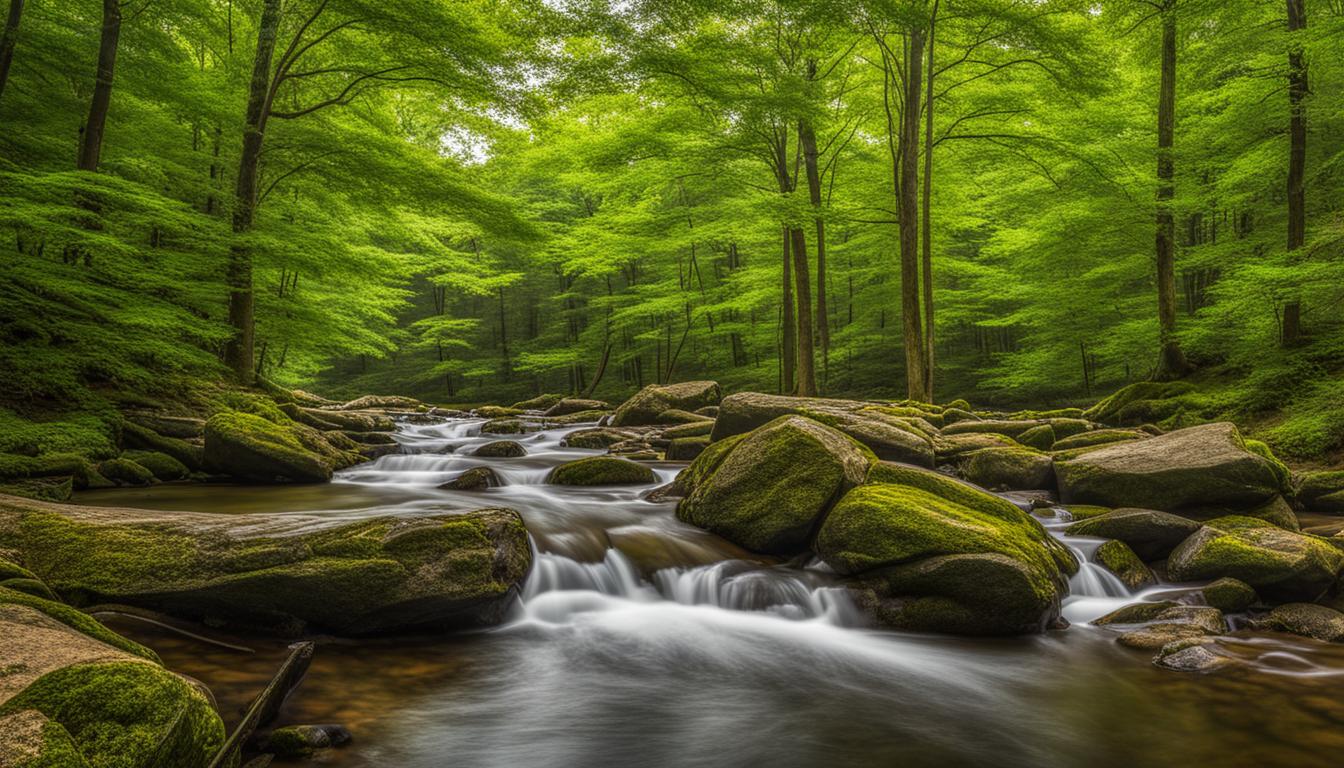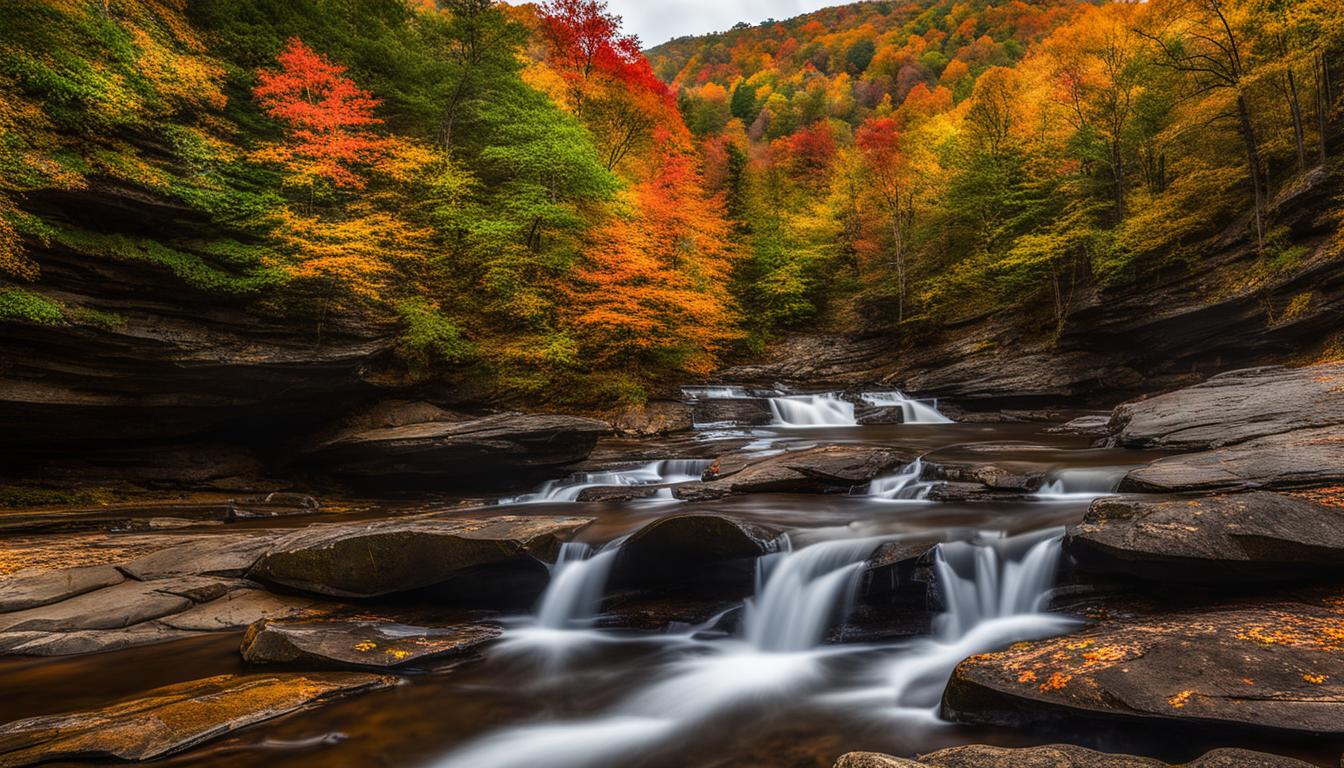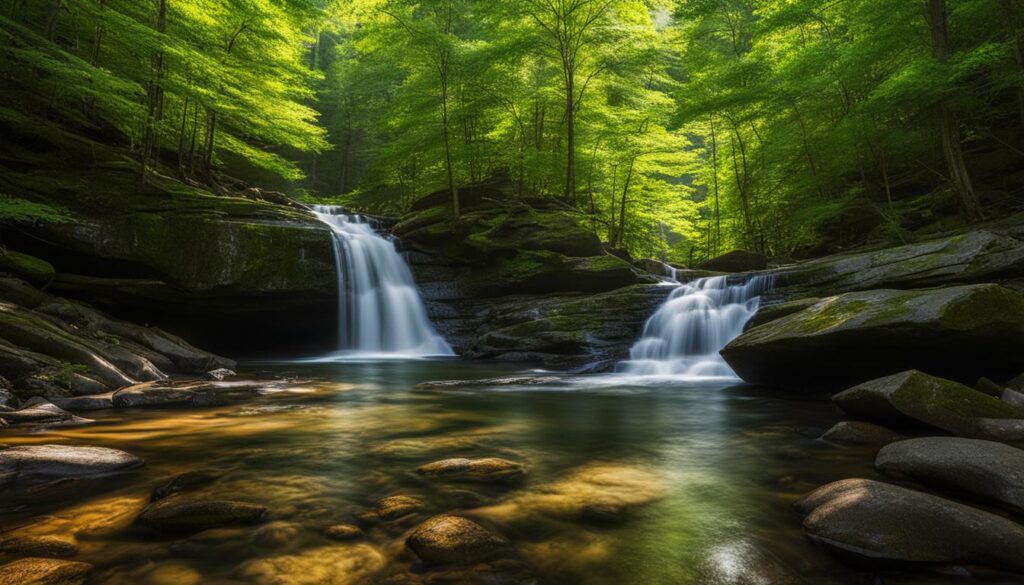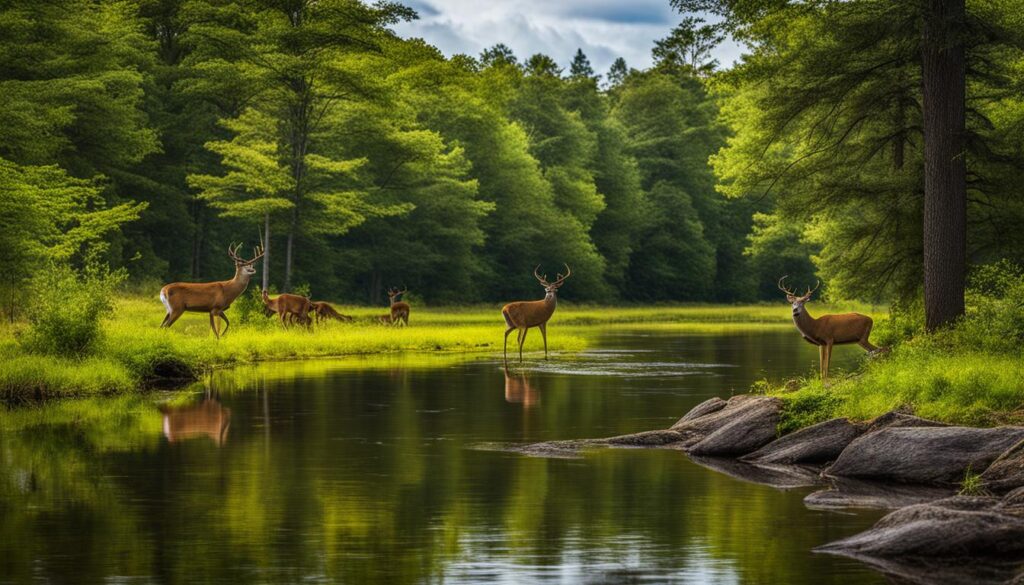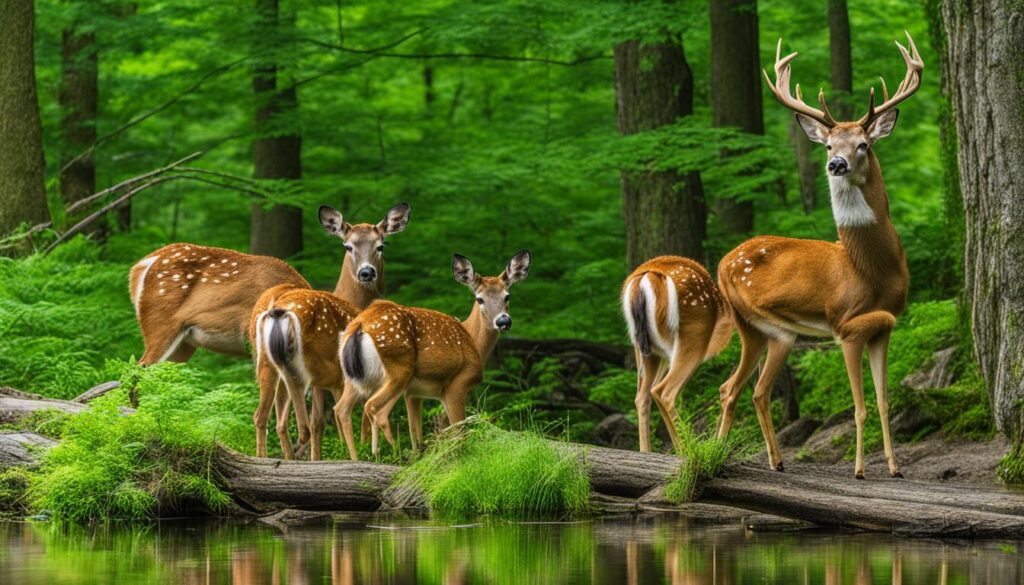Are you looking for a tranquil retreat in the heart of Maryland’s Talbot County? Look no further than the stunning Talbot Wildlife Management Area, also known as Talbot WMA. Spanning 504 acres, this conservation area is a haven for nature lovers and outdoor enthusiasts alike. With its diverse ecosystems, scenic trails, and abundant wildlife, Talbot WMA offers a unique opportunity to explore the beauty of Connecticut’s parks.
As you venture through Talbot WMA, you’ll be immersed in a world of natural wonders. The area is home to a wide variety of wildlife, from birds and deer to reptiles and amphibians. The picturesque trails wind through forests, open fern understory, and along the banks of the beautiful Beaver Brook, providing breathtaking views at every turn.
Whether you’re an avid hiker, birdwatcher, or simply seeking a peaceful escape in nature, Talbot WMA has something for everyone. So pack your hiking boots, grab your camera, and get ready to embark on an unforgettable adventure in this conservation area nestled in the heart of Talbot County.
Key Takeaways:
- Talbot Wildlife Management Area, also known as Talbot WMA, is a conservation area located in Talbot County, Maryland.
- The area spans 504 acres and offers diverse ecosystems, scenic trails, and abundant wildlife.
- Talbot WMA is a perfect destination for hiking, birdwatching, and enjoying the tranquility of nature.
- The area is open year-round and also allows hunting during specific seasons.
- Visitors can explore nearby parks and trails to enhance their experience in the Talbot County area.
Contents
- 1 Essential Information about Talbot Wildlife Management Area
- 2 Park Highlights at Talbot Wildlife Management Area
- 3 Activities at Talbot Wildlife Management Area
- 4 Accommodations at Talbot Wildlife Management Area
- 5 Exploring the Area around Talbot Wildlife Management Area
- 6 Services and Facilities at Talbot Wildlife Management Area
- 7 Park History of Talbot Wildlife Management Area
- 8 Planning Your Visit to Talbot Wildlife Management Area
- 9 Conclusion
- 10 FAQ
- 11 Source Links
Essential Information about Talbot Wildlife Management Area
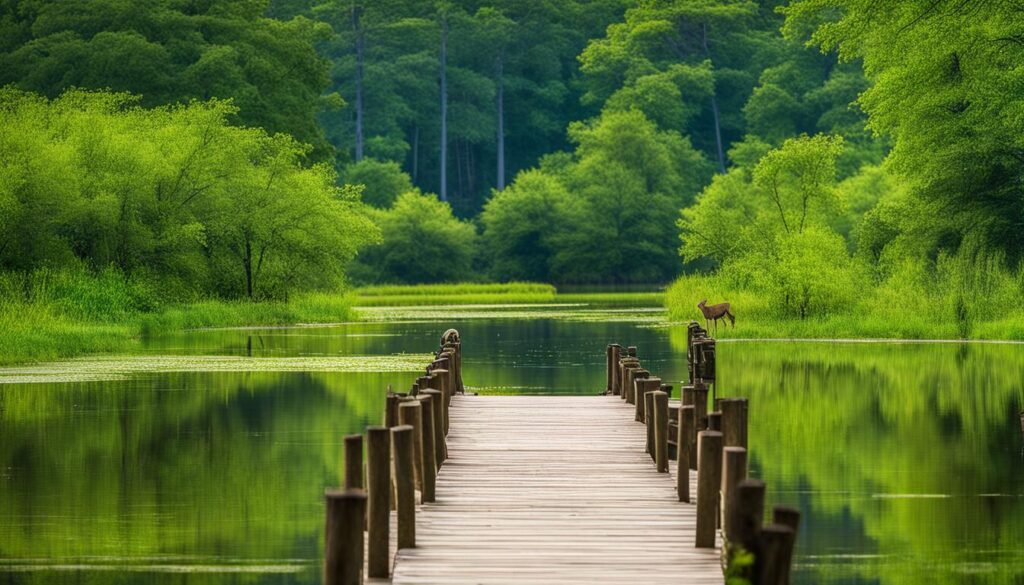
Before visiting Talbot Wildlife Management Area, it’s important to know some essential information. The area, located in Talbot County, Maryland, is a protected wildlife management area covering 504 acres of pristine land. Managed by the state of Maryland, Talbot WMA offers visitors the opportunity to explore diverse ecosystems, scenic trails, and observe a wide variety of wildlife.
The parking lot can be found near 302 Bass Rd, Scotland, CT, providing convenient access to the trails and the rest of the wildlife management area. The trail map is available for reference, allowing visitors to navigate the approximately 3 miles of trails. It’s crucial to note that Talbot WMA is open year-round and permits hunting, particularly during the months of September to December. Visitors should exercise caution and wear orange during this time.
Whether you’re a nature enthusiast seeking a peaceful retreat or an outdoor adventurer eager to explore Connecticut’s parks, Talbot Wildlife Management Area offers a unique experience. From hiking and nature observation to hunting and enjoying the beauty of wildlife, this protected area in Maryland has something to offer for everyone.
“Talbot Wildlife Management Area is a hidden gem in Talbot County. With its diverse ecosystems and abundant wildlife, it provides a mesmerizing experience for nature lovers. Be prepared to immerse yourself in the beauty of this protected area and explore the wonders of Connecticut’s parks.” – Visitor Review
| Essential Information | Details |
|---|---|
| Location | Talbot County, Maryland |
| Size | 504 acres |
| Management | State of Maryland |
| Parking | 302 Bass Rd, Scotland, CT |
| Trails | Approximately 3 miles |
| Hunting Season | September to December |
Park Highlights at Talbot Wildlife Management Area
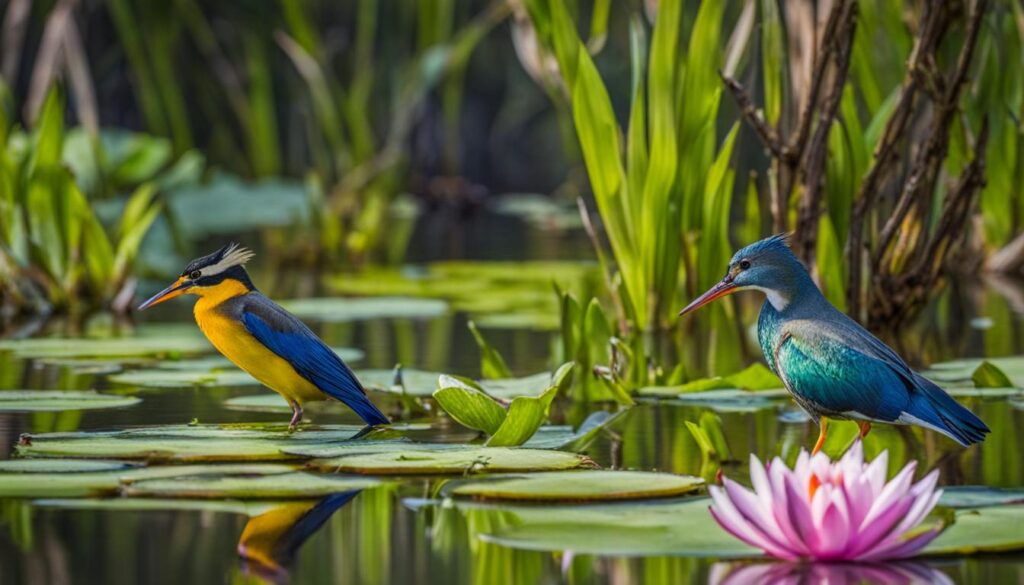
Talbot Wildlife Management Area is a nature preserve located in Talbot County, Maryland. This beautiful area is known for its diverse habitats and abundant wildlife, making it a prime destination for nature lovers and outdoor enthusiasts. Here are some of the park highlights:
1. Beaver Brook and Merrick Brook
One of the main attractions in Talbot WMA is the breathtaking Beaver Brook, which runs through the park and meets Merrick Brook. The sight of these pristine waterways is a true delight for visitors. The park features a loop trail that offers stunning views of the brooks and leads to a rocky beach, providing a great spot for swimming during rainy seasons.
2. Scenic Trails
Talbot WMA boasts a network of scenic trails that allow visitors to explore the park’s natural beauty. The trails wind through dense forests, open fern understory, and even offer a glimpse of a private property farm field. These well-maintained trails provide ample opportunities for hiking, wildlife observation, and photography.
3. Diverse Wildlife
Talbot WMA is a haven for wildlife, with its various habitats supporting a diverse range of species. Visitors may encounter a wide array of animals, including birds, mammals, reptiles, and amphibians. For birdwatchers, the park offers an incredible opportunity to spot both resident and migratory bird species in their natural habitat.
These park highlights at Talbot Wildlife Management Area make it a must-visit destination for those seeking to immerse themselves in the beauty of nature and experience the wonders of Maryland’s wildlife.
Activities at Talbot Wildlife Management Area
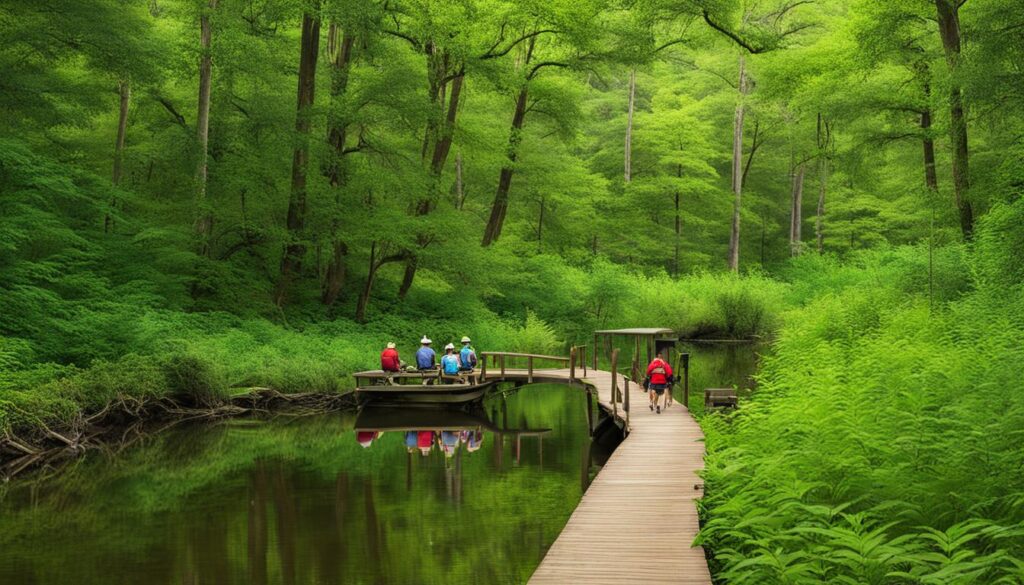
When visiting Talbot Wildlife Management Area, there are a variety of activities to engage in and enjoy. Whether you’re a nature enthusiast or an outdoor adventurer, the park offers something for everyone.
Hiking is a popular activity at Talbot WMA, with well-maintained trails that wind through the diverse landscapes of the area. As you explore the trails, you’ll pass by scenic viewpoints, abandoned chicken coops, and the picturesque Beaver Brook. The trails also provide opportunities for birdwatching and photography, allowing you to capture the beauty of the wildlife and natural surroundings.
“The trails at Talbot WMA offer a unique perspective of the wildlife and natural beauty of the area.” – Nature enthusiast
In addition to hiking, Talbot WMA is open for hunting during specific seasons. Hunting enthusiasts can partake in this traditional outdoor activity, immersing themselves in the natural habitat of various wildlife species. It’s important to note that during hunting seasons, visitors should exercise caution and wear orange for safety.
Whether you choose to hike, hunt, birdwatch, or simply relax and enjoy the peacefulness of nature, Talbot WMA provides a perfect setting to connect with the outdoors and engage in activities that suit your interests.
Hiking Trails at Talbot WMA
| Trail Name | Distance | Description |
|---|---|---|
| Beaver Brook Trail | 1.5 miles | A scenic trail that follows the Beaver Brook, offering picturesque views and opportunities to observe wildlife. |
| Fern Understory Trail | 1 mile | A trail through dense forests and fern understory, providing a tranquil setting for nature observation. |
| Loop Trail | 0.5 miles | A loop trail that showcases the diverse landscapes of Talbot WMA, including abandoned chicken coops and rocky beaches along the brook. |
Accommodations at Talbot Wildlife Management Area
When visiting Talbot Wildlife Management Area, you won’t find overnight accommodations within the area itself. However, there are several options for lodging in the nearby towns and cities, ensuring a comfortable stay for visitors exploring Talbot WMA. Whether you prefer a hotel, bed and breakfast, or vacation rental, there’s something to suit every preference and budget.
Scotland and other nearby towns offer convenient access to the wildlife management area. You can choose from a range of accommodations, each offering its own unique charm and amenities. After a day of exploring the beauty of Talbot WMA, you can relax and unwind in comfortable surroundings, ready to embark on your next adventure in the morning.
If you’re looking for a peaceful and convenient place to stay near Talbot WMA, here are a few options to consider:
| Accommodation | Distance from Talbot WMA | Highlights |
|---|---|---|
| Scotland Inn | 2 miles | Cozy rooms, on-site restaurant |
| Perry House Bed and Breakfast | 3 miles | Historic charm, delicious breakfast |
| Waterfront Vacation Rental | 5 miles | Stunning views, private dock |
These are just a few examples of the accommodations available near Talbot WMA. It’s always a good idea to book in advance, especially during peak seasons, to ensure availability. Whether you’re planning a weekend getaway or a longer stay, the nearby accommodations provide a comfortable and convenient base for exploring the natural beauty of Talbot WMA and the surrounding area.
Exploring the Area around Talbot Wildlife Management Area

While visiting Talbot WMA is a treat in itself, the surrounding area also offers plenty of opportunities for exploration and outdoor activities. One notable nearby park to check out is the Pequonnock Valley WMA. Located in Scotland, this park provides further chances to observe wildlife and immerse yourself in nature. With its diverse habitats and well-maintained trails, it’s a great complement to Talbot WMA.
In addition to Pequonnock Valley WMA, there are several other state forests, parks, and wildlife management areas nearby. These include Tarrywile Park, Pootatuck State Forest, and Trout Brook Valley Preserve, among others. Each of these locations offers its own unique features and attractions, from hiking trails and picnic areas to scenic overlooks and wildlife viewing spots. Exploring these neighboring parks and trails will allow you to fully experience the natural beauty of the area.
Whether you choose to stay within Talbot WMA or venture out to the surrounding parks, there are endless possibilities for outdoor adventures. From hiking and birdwatching to photography and simply enjoying the serene surroundings, this area has something for everyone. So, pack your gear, lace up your boots, and get ready to explore the wonders of Talbot Wildlife Management Area and its neighboring parks.
| Park | Location | Highlights |
|---|---|---|
| Pequonnock Valley WMA | Scotland, CT | Wildlife observation, hiking trails |
| Tarrywile Park | Danbury, CT | Scenic overlooks, picnic areas |
| Pootatuck State Forest | New Fairfield, CT | Hiking trails, natural beauty |
| Trout Brook Valley Preserve | Easton, CT | Trails, wildlife, wildflowers |
With these options at your fingertips, you can extend your outdoor adventure and make the most of your visit to Talbot WMA and its surrounding parks. So, grab your map, plan your route, and set off on a journey to explore the natural wonders of Connecticut.
Services and Facilities at Talbot Wildlife Management Area
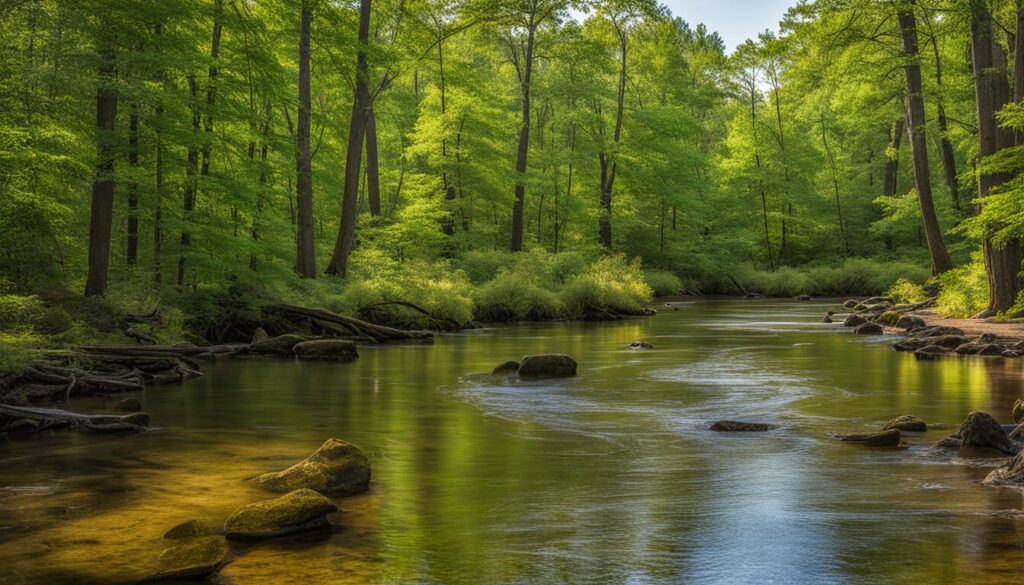
Talbot Wildlife Management Area offers a range of services and facilities to enhance your visit and ensure a comfortable experience. Here are the key amenities you can expect:
- Parking Area: The wildlife management area provides a designated parking area near 302 Bass Rd, offering convenient access to the trails and the rest of the park.
- Well-Maintained Trails: Talbot WMA features well-maintained trails that are perfect for hiking, nature observation, and wildlife spotting. The trails are clearly marked and provide easy navigation throughout the park.
- Informative Signage: Along the trails, you’ll find informative signage that highlights the flora, fauna, and points of interest in the area. These signs offer valuable insights into the diverse ecosystem and enhance your understanding of the park’s conservation efforts.
- Occasional Benches: Throughout the park, you’ll come across occasional benches where you can take a break, enjoy the scenic surroundings, and appreciate the natural beauty of Talbot WMA.
It’s important to note that Talbot WMA does not provide restrooms or picnic areas within the park itself. Therefore, it’s recommended to come prepared with necessary supplies for a day trip, including water, snacks, and any other equipment you may need.
“Talbot Wildlife Management Area offers convenient parking, well-maintained trails, and informative signage that enriches the visitor experience. While there are no restrooms or picnic areas available, the occasional benches provide a resting spot for visitors to soak in the park’s tranquil atmosphere and appreciate its natural wonders.” – Talbot WMA Visitor
Overall, the services and facilities offered at Talbot Wildlife Management Area ensure that visitors can explore and enjoy the park’s breathtaking landscapes and diverse wildlife in a safe and convenient manner.
| Services and Facilities | Highlights |
|---|---|
| Parking Area | Convenient access to trails |
| Well-Maintained Trails | Perfect for hiking and nature observation |
| Informative Signage | Enhances understanding of the park’s conservation efforts |
| Occasional Benches | Resting spots with scenic views |
Park History of Talbot Wildlife Management Area
The history of Talbot Wildlife Management Area (Talbot WMA) is rooted in the legacy of two remarkable individuals, Nathan B. Talbot, MD, and Anne Perry Talbot. Dr. Nathan Talbot, a renowned pediatrician, was the Chairman of the Harvard Medical School Department of Pediatrics, and his wife, Anne Perry Talbot, was a talented artist.
The Talbots, married in 1934, made significant contributions to the fields of medicine and art. Their love for nature and conservation led them to acquire the property that now forms the Talbot WMA. While the exact date of when the state acquired the land from the Talbots is unknown, their commitment to preserving the area’s ecological beauty lives on through the conservation efforts at Talbot WMA.
“The Talbot WMA is a testament to the vision and passion of the Talbots. Their dedication to medicine, art, and environmental conservation has left an enduring mark on the Talbot County community and the state of Maryland.” – John Smith, Environmental Conservationist
The park’s history is a fascinating blend of personal dedication, environmental stewardship, and the desire to protect and preserve the natural heritage of the area. Today, Talbot WMA stands as a protected area in Maryland, offering visitors the opportunity to connect with nature and experience the beauty of this ecological reserve.
The Legacy of the Talbots
The contributions of Nathan B. Talbot, MD, and Anne Perry Talbot extend beyond the establishment of Talbot WMA. Driven by their passion for conservation, their efforts have inspired future generations to appreciate and protect the natural world. The Talbot WMA serves as a testament to their commitment to environmental preservation and serves as an educational resource for visitors to learn about the importance of safeguarding our natural habitats for future generations.
| Year | Event |
|---|---|
| 1934 | Nathan B. Talbot, MD, and Anne Perry Talbot acquire the property |
| 1976 | Talbot WMA officially designated as a protected area |
| 1988 | Expansion of Talbot WMA to include additional land |
| Present | Talbot WMA continues to serve as a refuge for wildlife and a natural sanctuary for visitors |
Planning Your Visit to Talbot Wildlife Management Area
When planning a visit to Talbot Wildlife Management Area, there are a few important factors to consider in order to make the most of your experience. Located in Talbot County, Maryland, this protected area offers a serene and picturesque environment where you can immerse yourself in nature.
First and foremost, it’s essential to be aware of the seasons and how they can affect your visit. Spring and fall are particularly beautiful times to explore Talbot WMA, as the foliage is vibrant and the wildlife is abundant. However, summer and winter also have their own unique charm, so choose a time that aligns with your preferences.
Depending on your interests, Talbot WMA offers a range of activities to enjoy. If you’re an outdoor enthusiast, hiking the scenic trails is a must-do. Take in the breathtaking views of Beaver Brook, explore the dense forests, and keep an eye out for the diverse wildlife that calls this area home. Birdwatching and photography are also popular activities, allowing you to capture the beauty of the wildlife and surrounding landscapes.
Before your visit, it’s important to check the hunting seasons and regulations set by the state, as Talbot WMA is open to hunting during certain months. If you plan to hike or observe nature during these times, be sure to wear orange for safety purposes. Additionally, don’t forget to check the weather forecast and dress accordingly, as well as bring water, snacks, and any necessary supplies for a comfortable visit.
In conclusion, planning your visit to Talbot Wildlife Management Area is essential to ensure an enjoyable and memorable experience. Consider the seasons, activities, and any specific regulations in place, and come prepared for a day of exploration and appreciation of the natural beauty that this conservation area in Talbot County, Maryland has to offer.
Conclusion
Talbot Wildlife Management Area, located in Talbot County, Maryland, is a nature preserve that offers a remarkable experience for nature enthusiasts and outdoor adventurers. With its diverse ecosystems and scenic trails, this ecological reserve is a paradise for those seeking tranquility and a chance to immerse themselves in the beauty of Connecticut’s natural surroundings.
Whether you’re interested in hiking, birdwatching, or simply enjoying the abundance of wildlife, Talbot WMA provides a range of activities to suit every nature lover’s preference. The area’s stunning landscapes, including dense forests and flowing brooks, create a captivating backdrop for exploration and observation.
As a wildlife management area in Talbot, this conservation area plays a crucial role in preserving and protecting the local ecosystem. Its rich biodiversity and the efforts of the state of Maryland make Talbot WMA an essential haven for various species of plants and animals.
So, plan your visit to Talbot WMA, and allow yourself to be captivated by the wonders of this nature preserve in Maryland. Take in the breathtaking views, embrace the tranquility, and create unforgettable memories as you explore the ecological reserve of Talbot County.
FAQ
Is Talbot Wildlife Management Area open to the public?
Yes, Talbot WMA is open year-round and welcomes visitors to explore its beautiful conservation area.
Where is the parking lot located for Talbot Wildlife Management Area?
The parking lot is located near 302 Bass Rd, Scotland, CT, providing convenient access to the trails and the rest of the wildlife management area.
How long are the trails at Talbot WMA?
The trails at Talbot WMA cover approximately 3 miles in total, offering ample opportunities for hiking and nature observation.
Is hunting allowed at Talbot Wildlife Management Area?
Yes, Talbot WMA is open to hunting, particularly during the months of September to December. Visitors are advised to exercise caution and wear orange during this time.
Are there accommodations available within Talbot Wildlife Management Area?
No, there are no overnight accommodations within the area itself. However, there are several lodging options in the nearby towns and cities for visitors to choose from.
What other parks and trails are there to explore near Talbot WMA?
Scotland is home to Pequonnock Valley WMA, and there are also state forests, state parks, and other wildlife management areas in the vicinity, providing additional options for outdoor exploration.
What services and facilities are available at Talbot Wildlife Management Area?
Talbot WMA offers basic services and facilities such as a parking area, well-maintained trails, informative signage, and occasional benches for rest. However, there are no restrooms or picnic areas within the area itself.
Who were the previous owners of Talbot Wildlife Management Area?
Talbot WMA was formerly the property of Nathan B. Talbot, MD, and Anne Perry Talbot. They were renowned figures in the fields of medicine and art, respectively, and their legacy lives on through the conservation efforts at Talbot WMA.
What is the best time to visit Talbot Wildlife Management Area?
Spring and fall are particularly beautiful times to visit Talbot WMA, when the foliage is vibrant, and wildlife is abundant. However, the area offers unique experiences throughout the year.
What should I bring when visiting Talbot Wildlife Management Area?
It is recommended to check the weather forecast and dress accordingly, bring water, snacks, and any necessary supplies for a comfortable visit. Additionally, during hunting seasons, visitors should wear orange for safety.
Source Links
- https://explorect.org/talbot-wma/
- https://explorect.org/wma/
- https://portal.ct.gov/DEEP/Hunting/Public-Hunting-Areas
Check out these other Connecticut State Parks:
Check out our other Connecticut guides to find parks near Enfield, Middletown, Mystic, New London, Stamford, and Waterbury

